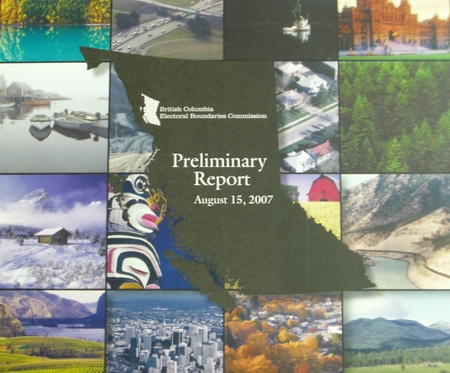Changes Would Give Lower Mainland the Power Though Rural BC Provides The Money
By 250 News

Electoral Boundaries Commission meets in Prince George September 5th, and can expect to hear from plenty of interested parties.
The Electoral Boundaries Commission can expect to get a lesson in financial reality when it meets in Prince George next month.
The Commission’s preliminary report calls for changes in the number of seats in the legislature. The reconfiguration would give the "604" control in the legislature.
In 2002, David Baxter and Andrew Ramlo, then both of the Urban Futures Institute, produced a report which showed there would be definite financial disparity if the province of B.C. were to be divided into urban and non urban sections.
The report developed one metropolitan area of Greater Vancouver and Victoria, the other would be comprised of the non-metropolitan area.
According to the Urban Futures Institute, if the metropolitan and non-metropolitan regions were, “provinces’, the non- metropolitan province would have $14,920 in international export income per capita and the, "city state”, would have only $4,278.
The report went on to say the trading relationships between these two regions would acknowledge the reality that the non-metropolitan regions would start out having three times as much per capita to spend than the ,"city states".
The authors say it is important for the two regions to work together "While metropolitan regions should work diligently to build strong metropolitan exports, until they do, it is in their best interests to ensure that the non metropolitan regions can attract and retain the people and investments that these resources need to produce the income that is shared."
Bluntly put, the report says 71% of the wealth produced in the province of British Columbia comes from the non metropolitan areas of the province.
The report goes on to reinforce the idea that the so called rural reaches of the province should receive representation based on the basic fact that they are major contributors to the province’s economy.
That information, according to leading business figures outside of the 604, somehow is being lost by the Electoral Boundaries Commission in its recommendation that the number of seats in the , "Rural Parts" of this province be reduced based solely on a population basis without factoring or considering any other areas at all.
Opinion 250 Editor, Ben Meisner says he will appear before the Electoral Boundaries Commission when it holds a session in Prince George on September 5th.
Meisner says he will try and drive home the point that population alone cannot be the criteria for determining what area will receive representation in the provincial legislature.
Meisner says adequate participation in the decision making process is critical for B.C. "Without the rural part of this province, the so called 604 would be in financial straits within a year and we who produce the wealth of this province must continue to receive a fair representation in the legislature."
The Commission had proposed to reduce the number of seats in the Cariboo-Thompson region from five to four, one less electoral district in the Columbia –Kootenay region from four to three, one less electoral district in the north from eight to seven, but adding four new districts in the lower mainland and one new electoral district in the Okanagan to bring them to seven from six.
In Prince George the representation in the legislature would go from three to two.
The City of Prince George has already served notice it will be holding a rally in the Civic Centre Square on the day of the Commission’s hearing in Prince George. (see previous story) The City of Quesnel has also indicated it will be attending the session to lodge its opposition to the proposed changes.
Previous Story - Next Story
Return to Home










"$14,920 in international export income per capita and the, "city state”, would have only $4,278"
Sounds good until you realize "international export income" is only part of the entire equation. The domestic economy is also an important factor, as is the multiplier effect of that income. The "city state" has a much, much larger "domestic economy" than we do simply because they have a much, much larger population. This was IGNORED in the Urban Futures report.
The report's arguement that only measuring the "first dollar" (the first dollar of course being a narrowly defined export dollar) is bogus because in the end it is ALL the dollars that count. It is bogus in the same way that concluding a "housewife" doesn't contribute anything economically to the family.
And dont' forget the impact of the big cash crop, pot, on our economy; the report doesn't count illeagal contributions to the economy.
I think everyone should go back and read the origninal report, understand what was measured and how (and what was not), and not listent to the simple phrases of the local politicians (and well-intentioned, but wrong, commentators) that say "all the money is created in the north."
It is certainly not, and the narrow focus, and suspect definitions, of the Urban Futures report does a disservice to us all.
I really wish we wouldn't quote it anymore. It's not being payed attention to anyway (and rightly so.)